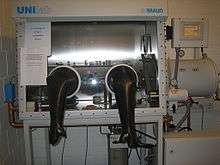Air sensitivity
Air sensitivity is a term used, particularly in chemistry, to denote the reactivity of chemical compounds with some constituent of air. Most often, reactions occur with atmospheric oxygen (O2) or water vapor (H2O),[1] although reactions with the other constituents of air such as carbon monoxide (CO), carbon dioxide (CO2), and nitrogen (N2) are also possible[2].
Method

A variety of air-free techniques have been developed to handle air-sensitive compounds. Two main types of equipment are gloveboxes and Schlenk lines.[3] Glove boxes are sealed cabinets filled with an inert gas such as argon or nitrogen.[4] Normal laboratory equipment can be set up in the glovebox and manipulated through the use of gloves that penetrate the walls of it.[5]. The atmosphere can be regulated to approximately atmospheric pressure and set to be pure nitrogen or other gas with which the chemicals will not react.[6] Chemicals and equipment can be transferred in and out via an airlock.[7]
A Schlenk line is a vacuum and inert-gas dual-manifold that allows glassware to be evacuated and refilled with inert gas specially developed to work with air sensitive compound, it is connected with cold trap to prevent vapors from contaminating a rotary vane pump[8]. The technique is modified from the double-tipped needle technique[9] These methods allow working in totally controlled and isolated environment.[10]
Air sensitivity compound
Substances that would react, explode or oxidise with air, such as organometallic compounds(chemical compounds which contains at least one chemical bond between a metal and carbon atom, including, alkaline earth, alkaline and transition metals, additionally,it may also include metalloids like tin, boron and silicon sometimes) encountered in chemistry are sensitive towards oxygen and moisture. Alkali metals and other pyrophoric compounds which react violently with water[11] can be handled safely using air free techiques.
Some semiconductors are air-sensitive.[12]
See also
References
- ↑ Handling and Storage of Air-Sensitive Reagents, Technical Bulletin AL-134, Sigma-Aldrich
- ↑ Dr. P. Wipf. "Techniques for handling air and moisture sensitivity" (PDF).
- ↑ W. Bouwkamp, Marco (2008). working with air and moisture sensitive compounds. Stratingh Institute for Chemistry, University of Groningen. pp. 4, 6.
- ↑ Glove Boxes, The Glassware Gallery
- ↑ Wipf, Dr. P (30 August 2015). techniques of handling air sensitivity compound (PDF).
- ↑ "Air Sensitive Sample Analysis | Reduced Oxygen Moisture-Free Handling". Analysis of Carbon, Hydrogen, Nitrogen, Oxygen, and halogens including Fluorine. Retrieved 2018-02-27.
- ↑ "Handling air‐sensitive compounds" (PDF).
- ↑ "The Glassware Gallery: Schlenk Lines and Vacuum Lines". www.ilpi.com.
- ↑ Laura J. Smith Vosejpka (1969). "Technique for the Transfer of Air-Sensitive Solutions". Pubs.ac.org.
- ↑ "Air-Sensitive Chemistry - Labware | Sigma-Aldrich". Sigma-Aldrich.
- ↑ "Pyrophoric Control - FQE Chemicals". FQE Chemicals.
- ↑ "Application of Air-sensitive Semiconductors in Nanoelectronics". www.sciencenewsline.com.